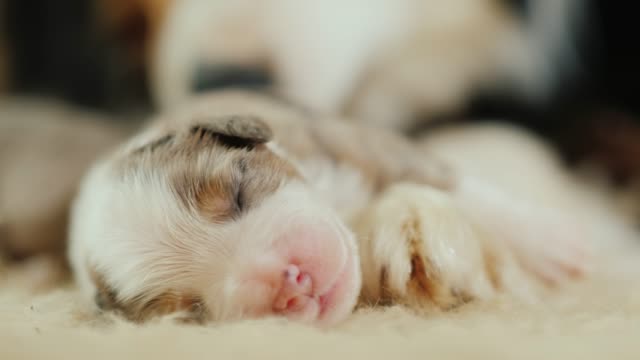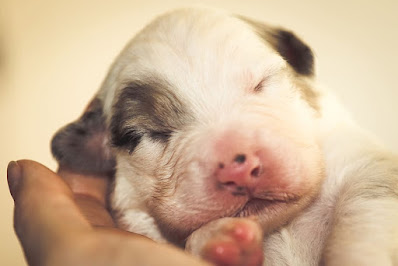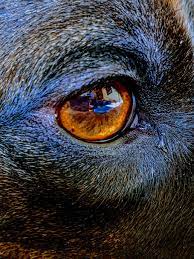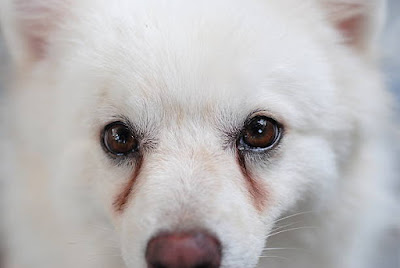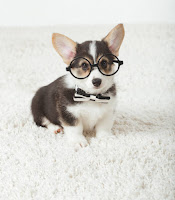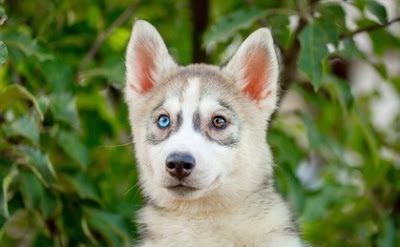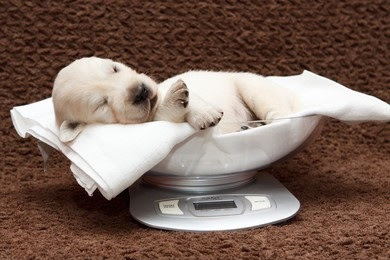When Can Newborn Puppies See, Smell And Hear ?
Puppies in their early stages require special attention. A dog is still a baby at one week old, and she is completely reliant on her mother. She'll start to develop into a young puppy in the next weeks as she grows out of her infancy. Between the ages of one and eight weeks, puppies go through a lot of exciting changes.
They can see, hear, walk, and urinate/defecate on their own at 3 to 4 weeks. Despite the fact that their brains are still growing, infants can learn certain things. Of course, these small puppies should stay with their mother and litter mates until they are eight to twelve weeks old.
Physical Development
Puppies' eyes are still closed at one week old. Their eyes will open in the second week of life, between the ages of 10 and 14 days. They will, however, initially be unable to see well. Gradually, the eyes will open wider, exposing grayish-blue eyes that seem blurry. Puppies' eyes will continue to grow over the following few weeks, with complete eyesight expected around the age of eight weeks.
Puppies' ears open shortly after their eyes, usually around 14 to 18 days of age. Until the puppies are roughly eight weeks old, their hearing will continue to develop.
For the first two weeks of their lives, newborn pups are unable to maintain their weight, so they crawl around on their stomachs, paddling and pushing with their legs to gain strength. Between days 15 and 21, the majority of pups will be able to stand on their own. Around 21 to 28 days of age, they begin to walk with an unsteady stride.
For the first few weeks of their lives, puppies must be encouraged to urinate and defecate. This is accomplished by Mom licking the anal and vaginal regions. If you're parenting an orphaned puppy, stimulate the region with a warm, wet towel or cotton ball. Around three to four weeks of age, puppies begin to gain the capacity to pee and defecate on their own.
Puppies do not have teeth when they are born. Their infant teeth, often known as "milk teeth," will appear between the ages of two and four weeks and will last until around eight weeks.
Why Are Puppies Born With Their Eyes Closed?
Every animal's young are distinct in terms of development when they are born. Many reptiles are totally independent at birth, and marsupials continue to grow in the mother's pouch for months. Dogs are at the middle of the spectrum. For the first few weeks of their lives, they are completely reliant on their mother's care, and they are born deaf and blind.
Puppies are born with their eyes closed because their eyes aren't fully grown when they are born. The eyes will continue to grow over the following two weeks, which means they must be shielded from external elements that might harm them. This includes light, airborne contaminants such as dust or dander, and possible scratches from littermates who haven't yet mastered paw coordination.
Even after a puppy's eyes have opened, it's critical not to expose them to too much bright light before they are ready. If your puppy has white spots on its eye or doesn't seem to be able to see objects by 3 or 4 weeks old, it's possible that the puppy is blind or has an eye problem that necessitates a doctor visit.
Always remember not to push a puppy's eyes to open. When the time comes, each breed, litter, and puppy within that litter will open their eyes at their individual speed. Infection, eye damage, and even permanent blindness can result from forcing their eyes open before they are ready.
Mother dogs usually know exactly what to do to nurse and rear their newborn puppies, but taking a puppy home to your human family might be an entirely other experience. In Purina Canada's library of dog and puppy articles, you'll find advice on feeding, toilet training, and exercising your new puppy.
How Well Can Puppies See?
Puppies can't see their worlds during the first two weeks of their life. Their eyes open between 14 and 21 days of age, although their vision is still limited. Because humans rely greatly on sight, we naturally want to know if our dogs do as well.
You've probably heard the prevalent assumption that dogs are colorblind. This isn't completely accurate. According to the Merck Veterinary Manual, dogs' eyes have fewer cones in their retinas that are responsible for color vision than humans'. Although your puppy can sense color, we may reasonably assume that he cannot see the same spectrum as us. Choose blue or yellow toys if you want your puppy to be able to distinguish between them.
Don't worry, your dog isn't going to be left out. Puppies may not have the same color spectrum as humans, but they see in the dark far better. Puppies' eyes have more rods than ours, therefore they can see in low light far better than we can.
However, when it comes to the finer points, we still hold the upper hand. Have you ever wondered why your dog can't always see the treat in front of him but can generally track a treat or toy you throw? This is due to the fact that dogs are natural hunters. Their vision has evolved to detect movement rather than tiny details.
How Your Puppy’s Eyes Develop
When a puppy's eyes first open, they seem milky and grayish-blue, but this fades with time. The eyes of a puppy do not fully grow until it is 4–5 weeks old. Todd claims that pups can see before they can hear (their ears open at 18–20 days).
The tapetum lucidum of a puppy develops as his eyes mature. This is the layer of tissue beneath the retina that aids in the development of night vision in animals. (It's also what gives your pet a creepy green glow when you photograph them with a flash camera.)
How to Clean Stains Around a Puppy's Eyes ?
Mucus or continuous tearing causes discoloured spots around puppies' eyes. Teething, eye infections, genetics, incorrectly formed tear ducts, allergies, and sensitivities to contaminants in food and drink are all factors that might contribute to the issue. Stains are very easy to remove; however, keeping the area clean will prevent them from reappearing.
Step 1
To keep the hair around your puppy's eyes short, go to a groomer and get it cut on a regular basis. Longer hair traps tears or mucus, resulting in discoloration. Hair that is shorter is easier to clean and maintain.
Step 2
Wipe the hair out of your puppy's eyes on a regular basis—or more frequently if his eyes are always watering. Wipe tears and mucus from the hair with a cotton ball or soft towel soaked in warm water. This will remove existing stains and prevent the formation of new ones.
Step 3
Contact lens saline solution can be used to remove stains. Apply a saline solution on a cotton ball or swab and gently massage it into the stain. Wipe it down with a clean cloth and do it again. Saline is used in commercial eye and stain washes for dogs, and the contact solution's little quantity of boric acid helps to lighten the stains. Use on a regular basis to keep stains from reappearing.
Watch for Eye Infections
It's even more vital to keep your pup's environment clean during this critical physical growth period to avoid diseases. Conjunctivitis is the last thing your puppy needs at this important time. Conjunctivitis can result in irreversible blindness if left untreated.
Overall, when it comes to early eye care for your puppy, the best thing you can do is let nature take its course. Certainly, keep an eye out for any crusty build-up on the eyes or any other signs that something is wrong, but for the most part, just enjoy your puppy's transformation from a blind, deaf fur ball to a bouncing, joyful animal.
What Is the Average Age of a Dog When Glaucoma Occurs?
Glaucoma causes irreversible damage to the optic nerve and blindness in the damaged eye of a dog if it is not treated. According to PetMD, 40 percent of dogs with glaucoma will go blind within the first year of their diagnosis, whether or not they have had medical treatment. Glaucoma can strike at any age, although the majority of dogs with primary glaucoma are identified in their later years.
Average Age of Onset
Glaucoma is divided into two categories. Primary glaucoma strikes dogs between the ages of three and seven. Trauma, cataracts, inflammation, and malignancy are all causes of secondary glaucoma. Glaucoma is caused by an accumulation of fluid in the eye, resulting in high intraocular pressure in both types of glaucoma. The lack of fluid outflow in primary glaucoma is caused by the eye's filtration angle being too narrow. According to the North Carolina State University College of Veterinary Medicine, this morphological characteristic is most typically seen in purebred dogs.
Tibetan Spaniel Eye Problems
Tibetan spaniels are exceptionally friendly companion dogs that originated in Tibet's Himalayan mountains. Tibetan spaniels, although being typically healthy dogs, are susceptible to genetic disorders, particularly eye problems. In Tibetan spaniels, eye issues such as cherry eye, entropion, progressive retinal atrophy, and retinal dysplasia are frequent.
Cherry Eye
The red lump in the corner of the eye is the first sign of cherry eye. nictitans gland prolapse is another name for cherry eye. The gland that makes tears is found in the corner of each eye, although it is not visible to the naked eye. When a dog has cherry eye, the gland emerges from its regular hiding place, exposing it to the environment and resulting in redness, swelling, irritation, and mucous discharge. Cherry eye is caused by a weakening of the tissue that connects the gland to the eye's surrounding structures. Cherry eye is treated with a simple surgical procedure done by a certified veterinarian.
Eyelid Entropion
Eyelid entropion occurs when the eyelid rolls inward, causing the hair on the surface of the eyelid to brush against the bottom region of the eyeball or the cornea, causing irritation to the eye. Constant irritation to the cornea can lead to corneal erosion, ulcers, and scarring, all of which can impair vision. While some Tibetan spaniels do not exhibit indications of distress, others will close their eyes and cry profusely. Surgical correction is required for treatment, however the prognosis is often favourable.
Progressive Retinal Atrophy
The surface of the back wall of the inner eye, often known as the retina, is affected by progressive retinal atrophy. This genetically inherited condition affects both eyes at the same time and impairs vision in dim and bright light. The capacity to see in low light is first harmed. The capacity to sense bright light deteriorates over time. Blindness will ultimately ensue as the condition progresses. The sickness and symptoms are painless and appear in Tibetan spaniels between the ages of 18 months and four years. At this time, there is no treatment for progressive retinal atrophy. Tibetan spaniels are noted for their ability to swiftly adapt to blindness and navigate using their other senses.
Retinal Dysplasia
Retinal dysplasia is a condition in which the retina develops improperly and is passed down through the generations. The anomaly can take three different forms, ranging from minor to severe. The retinal folding is the mildest kind. The second is retinal thinning, folding, and disarray, and the third, and most severe, is retinal detachment. The second and third kinds might cause visual problems or perhaps blindness. There is currently no therapy available.
How Puppy Vision Is Assessed ?
By discreetly tossing cotton balls into the air and studying the puppy's visual response, visual evaluation may be tested. The typical puppy should imitate the hand action and then observe the cotton ball as it flies through the air before landing on the floor. It's crucial to avoid making any noises since the puppy may respond to the noise rather than the visual stimulation. Adult dogs' eyesight can also be assessed using this vision test.
Do Dogs See Colors ?
It is a common misconception that dogs can only see black and white. While dogs are unable to perceive all of the hues of the rainbow, they can discern shades of specific colours. Dogs are said to be able to perceive hues of blue, yellow, green, and greyish brown. Humans have an edge in detecting tiny details, while dogs can see in poor light and detect movement better than humans.
How Old Are Dogs When Their Eyes Change Color ?
You won't see anything of a puppy's peepers for at least eight to fourteen days if you're gazing at a fresh new litter. You'll notice that the eyes seem blue once they start to open. The colour of his mature eyes is determined by his dog's genetics.
Sight and Color Change
Around day 14, puppies' eyes begin to focus. Between days 21 and 28, you're unlikely to detect much of a change in his eye colour. Because brown is the dominant gene for doggie eye colour, you may observe a tone of that hue emerge. The colour of his eyes does not change overnight; it might take another 12 weeks for them to fully mature.
Coat Color and Eye Color
Amber eyes are more common in puppies with liver-colored fur. Amber eyes can be light brown, yellow, or even grey in colour. The gene for a merle coat is linked to blue eyes. The pigmentation of the eyes is diluted as a result of this. The piercing blue eyes of Siberian huskies are genetically unrelated to coat colour.
Do Dogs Close Their Eyes When They Sleep?
Don't be frightened if your dog appears to be sleeping but his eyes are open; people close their eyelids when they sleep, but not all dogs do. It varies on the breed and the particular dog, but your dog could be able to keep his eyes open, even if just slightly, when he's sleeping.
Open and Closed
When a dog sleeps with his eyes wide, the lids may slide back into his skull, exposing only the whites. If you look closely, you can see the eyeballs moving whether they're closed or not. This is a normal feature of REM sleep in dogs, just like it is in people. However, you shouldn't expect your dog to sleep with his eyes open all of the time because certain breeds are simply more prone to it than others. Greyhounds and dogs with bulbous eyes, such as pugs, are more likely to display at least one eye while sleeping.
How to Groom Around the Eyes of a Maltese Puppy ?
Because a dog's eyes are one of his most delicate features, grooming around them must be done with extreme caution. Because their fur is long, it gathers tear stain - a wet darkening around the inside border of a dog's eye — and becomes matted readily, Maltese in particular require frequent brushing. When brushing Maltese pups around the eyes, use extra care since they are sensitive to grooming products and hard handling.
Each time a puppy is bathed, groom his eyes.
Hold your puppy's head firmly against your chest, but not too tightly. While you're working around her eyes, the Maltese puppy shouldn't be able to make any rapid movements.
Brush the outside of the eyes with a fine-toothed metal comb. Begin by brushing the hair away from the eye with the brush held near to the edge of the eye.
When bathing the puppy's face and around her eyes, use a no-tears puppy shampoo.
To remove any tearstain, lather the no-tears puppy shampoo near to the puppy's eyes. Because Maltese have delicate, light-colored fur, tearstain is highly visible on them.
Rinse the shampoo completely off the puppy's face.
Soak a washcloth in a liquid tear-stain remover for a few minutes. Wrap the cloth over your index finger and gently wipe away solid debris with your fingertip, such as a tear stain that has developed into a crust on the inside border of your eye.
How Well Can Puppies Hear?
Puppies are born deaf, and hearing is the last sense to fully develop in them. They don't have the ability to hear until they're roughly three weeks old. They can hear four times better than most people after their hearing improves, including a broader spectrum of frequencies.
You've undoubtedly noticed that your puppy has the ability to hear sounds that you don't. Long before the thing or person comes into view, you've seen her crane her head to one side and glance out in the distance.
Dogs' ears have far deeper canals than ours, allowing sound to travel more efficiently to their eardrums. Because of the 18 muscles that fine-tune the ear's position and effectively "turn up the volume" on their hearing, all dogs, but especially those with upright ears, such as German Shepherd Dogs, utilize their ears almost like radar antennae.
"This can also make dogs more sensitive to some loud noises than humans, which explains why thunder or fireworks can be perplexing, frightening, or even painful," says AKC chief veterinary officer Dr. Jerry Klein.
How Well Can Puppies Smell?
Your puppy's sense of smell is significantly superior to yours when it comes to scent. The sense of smell of a dog is 10,000 to 100,000 times more sensitive than that of a human. Dogs have almost 300 million olfactory receptors, compared to roughly 6 million in humans. A dog's brain (which is around 40 times bigger than a human's) is dedicated to finding out what those odors are. People also smell and breathe through the same airways, but a dog's nose is designed to separate these functions.
It's no surprise that we utilize dogs to sniff out bombs, narcotics, and missing persons, which also explains why your puppy can scent where the treats are hidden.
Puppies use their sense of smell to navigate from the time they are born, when their eyes are closed and their hearing is still developing. Jacobson's organ is a peculiar organ found on the roof of a dog's mouth. Adult dogs sense pheromones from female dogs in heat or from dog urine, and puppies utilize it to find their mother and her milk.
Dr. Klein explains, "Your puppy sees, hears, and smells the world differently than you do." "This is part of what makes rearing a puppy so thrilling, and why humans and their canine partners have such a particular bond."
Some breeds have developed senses to a greater extent than others. Bloodhounds, for example, have extremely strong noses, but sight hounds, such as Greyhounds, are better at detecting game. Learning as much as you can about your puppy's senses and how he interacts with the environment can help you better understand his requirements and make you a more knowledgeable and responsible dog owner.
Behavior Changes
The first two weeks of a puppy's existence are primarily about sleeping and feeding. Physical changes occur after 14 days of age, and they open up a whole new universe. They start seeing, hearing, and walking. They begin to explore the world and learn about being dogs around the age of 21 days. This is also the start of the socializing process. By associating with her mother and litter mates, she is learning how to socialize with other canines. Human socialization is also crucial at this period.
The first "fear phase" will occur around the age of seven to eight weeks. Most pups appear to be wary of new things at this age. Anything you may introduce her to prior to this time may assist her in getting through the fear stage more quickly.
Health and Care
Mom will continue to provide the majority of the care for her puppies until they are fully weaned between the ages of five and seven weeks. After three to four weeks, though, her puppies will grow less and less reliant on her. It's possible that the pups will leave their "nest" and explore the rest of the house. When you're not at home, it's probably best to keep mom and the puppies in an exercise pen.
The puppies' first few weeks of life are a period of fragility. If a puppy is not developing as quickly as her littermates, she should see a veterinarian as soon as possible. Furthermore, any symptom of disease, no matter how little, must be handled carefully.
Training and Socialization
Puppies between the ages of one and three weeks are still too young to be trained or socialized. They can see, hear, walk, and urinate/defecate on their own at three to four weeks. Despite the fact that their brains are still growing, infants can learn certain things.
Of course, these small puppies should stay with their mother and litter mates until they are eight to twelve weeks old. You may start introducing the cage and basic toilet training as early as three to four weeks of age. Even if the puppies will be adopted between the ages of eight and twelve weeks, you may begin preparing them for training.
Early socializing occurs between the ages of four and seven weeks. The puppy must stay with its mother for the time being, but it is now ready to be exposed to new sights and noises. It should begin with interacting with people of all ages and looks. This includes youngsters who understand how to behave around dogs and will carefully handle the puppy.
Food and Nutrition
Puppies obtain their nutrients from their mother's milk during the first three weeks of their lives. Puppy formula can supply the required nutrients if the puppy was orphaned or need additional feeding.
The pups may be ready to start weaning when their baby teeth have sprouted, about three weeks of age. When Mom feels those puppy fangs biting at the teats, she may automatically start this process. Bringing out some canned puppy food or softened puppy kibble is a fantastic approach to ease the pups onto dog food (use warm formula or water to soften the kibble). Make sure you get a growth-oriented dog food. By giving them a sample from your finger, you can persuade them to consume it.As the puppies become accustomed to the puppy chow, they will stop nursing. By six to seven weeks of age, most puppies are completely weaned.
How Do I Feed a Newborn Puppy?
During the first few days of feeding, antibodies in their mother's milk provide crucial germ protection to brand born puppies. Colostrum is a milky-textured fluid produced by dog mothers that gives puppies the capacity to fight illnesses.
It is critical that your puppy suckle from their mother for as long as possible in order to obtain this ingredient. If their mother dies or rejects them, you must contact your veterinarian immediately to ensure that you receive the vitamins that pups require to thrive.
Puppies that are unable to breastfeed can be fed by you after the first few weeks. Ask your veterinarian for advice on getting the puppy to nurse from a bottle or tube if you're not sure how to accomplish it. If a puppy refuses to drink from the bottle, take him or her to the veterinarian right away; he or she may need to be fed through a stomach tube.
You'll want to make sure you get a canine-specific formula. Make sure the puppies can nurse from the bottle by working with them.
Puppies should be fed on their stomachs while lying down. It's possible that they'll choke if they're in another position. Warm the milk to around 100 degrees Fahrenheit, or body temperature, as you would for a human baby.
However, instead of heating the formula in the microwave, place the bottle in a cup of warm water. The milk is warm enough when you can touch it to your skin and feel a tiny warmth. Pat your puppy on the back after feeding to help them burp out any air they may have ingested.
How Often Should a Puppy Eat?
Newborn puppies feed every 2 to 3 hours on average. You'll be as preoccupied with them as you would be with a human child. If you're making your own formula, the directions on the package should tell you how much to feed them. You may discover that your dog need more or less than the box suggests. Make a mental note of how much money you're making per feeding.
Puppies need a warm environment in which to sleep and feed. For the first several weeks of their lives, their body temperature remains unregulated. They can't consume or digest their food correctly if they're chilly.
This means you'll need to provide a source of heat in their nesting box inside a towel or blanket. Place it adjacent to a non-heated area so they may escape if it becomes too hot.
You may observe your puppy biting or chewing on its bottle at the age of 3 to 4 weeks. This might indicate that they're ready to start consuming soft or semi-solid foods. When they initially start eating, you might need to combine formula with canned dog food. When you find your puppy chewing on the bottle, consult your veterinarian for advice.
If your puppy is between the ages of 4 and 6, he or she should be eating solid food from a dish on their own. For quantities, follow the instructions on their food bag. Puppies between the ages of 6 and 12 weeks should be fed four times each day.
How Much Should a Newborn Puppy Weigh?
The recommended weight for your newborn puppies varies by breed. They can range in weight from 2.5 ounces to 2.25 pounds.
The amount of weight they acquire, though, is often the same. For the first two weeks, you should weigh them every day, and then at least every three days for the first year. Take note of their weight when you weigh them. Depending on the breed, they should grow about 10% of their body weight every day.
During their first year of life, puppies should acquire weight fast. Call your veterinarian if you detect any unexpected weight loss. According to studies, pups should lose part of their birth weight in the first week of life and then double it. Within three weeks, your puppy might gain up to six times its birth weight, depending on the breed and size.
How Can I Help a Puppy to Go to the Bathroom?
Puppies can't go to the bathroom on their own when they're born. Their mother licks their genital and anal sites, stimulating the muscles and nerves and causing the pups to urinate. If your puppy is orphaned or hasn't been taught by their mother, gently rub these places with a washcloth or cotton ball soaked in warm water, simulating their mother's licks.
When Should Puppies Have Their First Vet Checkup?
Most veterinarians recommend bringing your newborn dog in at the age of six weeks. The mother's antibodies fade off over time, resulting in this timeframe. Puppies are more susceptible to infection and sickness. Your veterinarian will give your puppy their first vaccines and deworming medicine during their first physical checkup.
Around the age of six weeks, your puppy should receive their first vaccines. The following vaccinations are recommended for new puppies:
- Distemper virus
- Adenovirus
- Parainfluenza virus
- Parvovirus
You'll need to make sure your puppy gets these follow-up vaccines around the age of 8 to 12 weeks:
- Bordetella
- Canine Influenza H3N2 and H3N8
- Rabies first year
- Leptospirosis
The physical examination informs your veterinarian whether any issues need to be treated. They'll inquire about feeding and the care you've provided, as well as provide recommendations for future care.
Planning for Newborn Puppy Care
If you want to buy your puppy from a breeder or a store, look for one that does not separate puppies from their mothers too soon. Different people have different ideas about when this time is. In general, 7 to 8 weeks is regarded long enough for children to be trained to pee and have bowel motions by their mother.
You'll need to have defined areas for potty training your puppy and have your home dog-proofed. This entails safeguarding everything they can gain access to that might be harmful to them. Prepare a strategy for how you'll train them and keep them healthy.
It's critical to use soft, warm blankets over a warming pad (also known as a whelping pad) in a nesting box with a non-heated zone. You'll also need puppy formula and bottles to feed them if you know they're still breastfeeding. Food and water dishes, as well as puppy-specific food based on your pup's size and breed, should be on hand.
Call your veterinarian for new puppy advice if you have any questions or concerns.

